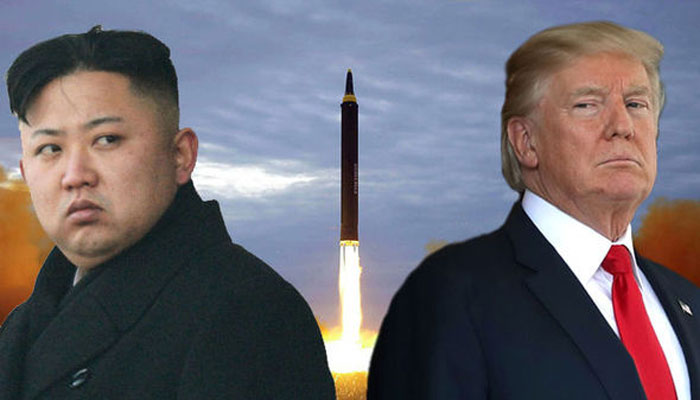An inevitable war?
October 09, 2017

The world is getting ready to witness another theatre of a terminal war in Asia. The only difference this time is that it’s going to be the first millennial bombing on a non-Muslim and nuclear power.
Some believe that if North Korea were a Muslim state, Kim Jong-un would have met the fate of Saddam or Qaddafi years ago. But the ground reality is somewhat different. Threatened by adversaries and increasingly isolated by long-term allies, the relatively young Jong-un is a wounded bear bent upon fighting to the end and in that destroying everything coming in the way. The stakes are so high that, theoretically, more lives are in danger than all those lost in all the recent wars combined.
As war looms over it, nothing is more important for North Korea than its strategic location. The very lifeline of North Korea is its ally China, with which it shares a densely populated long border, almost equal to the distance between Karachi and Islamabad. Russia shares a relatively very small and sparsely populated land area with North Korea, almost equal to the distance between Rawalpindi and Islamabad. The maritime distance with Moscow is also insignificant but Putin is monitoring the situation very closely as his enemy is marching towards another frontier. Unlike Pakistan that has, unfortunately, estranged almost every neighbour, Pyongyang has thorny relations with only one bordering country – South Korea. Since the bloody divide in 1945, both dream unification to their advantage but are technically at war with each other.
Jong-un might not have inherited wisdom from his late grandfather but he definitely has his warrior genes. The DPRK’s revolutionary founder, Kim II Sung, who fought a successful guerrilla war against the Japanese colonial forces in 1945, left a legacy of resistance. Upon his death, the country witnessed the beginning of a dynastic rule as his son Kim Jong-il became the successor and inherited – among other things – a nuclear programme. Il might not be remembered for his individuality but will always be credited for testing the first nuclear weapon as the six-party talks failed, thanks to the unrealistic preconditions of the Bush administration which insisted on complete dismantlement.
No country other than South Africa has given up its nuclear weapons while others have only improved them. As Jong-il realised that the economic noose was being tightened around his country and the US was opting for a ‘my way or the highway’ attitude, he went ahead on the missile launch and even broke the commitment to halt nuclear developments. Young Jong-un assumed office after the collapse of those talks. He also knows the invasion tactics of the US, which offers a sugar-coated bait of security guarantees and improved diplomatic and economic relations for disarmament. The fall of Libya strengthened Jong-un’s conviction that only nuclear weapons and ballistic missiles could save his country.
The most fortunate thing for Jong-un is his country’s geography. Pyongyang and Seoul are closer than the distance between Karachi and Hyderabad, with Seoul around 50 kilometres of the border. By deploying more than 13,000 artillery pieces along this border, North Korea has left no stone unturned to scare its next-door neighbour. Even if two-thirds of the artillery pieces hit the world’s ninth most densely-populated capital city, where almost half the country’s population lives, the DPRK has the power to turn Seoul into a living hell.
Around 150,000 US citizens live in South Korea, and the country’s capital is home to 40,000 Americans and 15,000 Japanese nationals. American casualties in both the Afghanistan and Iraq wars are still less than 7,000; so, imagine how damaging even a conventional war can be for the two allies. Militarily, there is no comparison between a country that has recently tested the mother of all bombs in Afghanistan and has sophisticated nuclear, biological and chemical weapons of every possible scale to the one and a country that has almost everything that is outdated. But, this makes not only South Korea but also Japan and the US even more vulnerable as the so-called hermit kingdom may not wait to try its recently upgraded nuclear arsenal as the last resort.
Increasingly seen unavoidable, a war between the US and North Korea will be tragic on an unbelievable scale. Due to the South Korean involvement, we could see families and extended families fighting each other. Such a war also has the potential to destroy the most modern infrastructure that is in place in at least South Korea and Japan, costing trillions of dollars to both world economies and resulting in a possible domino effect for other nations.
The Swiss-educated Kim Jong-un, shown on media with largely broad smile on his face, may be ruthless like those rulers who don’t even spare their own blood relatives for power. But those who are on the opposite side are hardly angels – and may even be worse. After months of blusters and sabre-rattling – followed by a most undiplomatic verbal attack by Trump in the United Nations – Jong-un knows being tamed into talks is really a bait. To him, the enemy is eyeing the more than 10 trillion dollars worth of two hundred types of minerals that North Korea has under its mountains not to mention gold and even rare earth metals used in our smartphones and other high-tech products.
The way ahead is dark, although a ray of hope may emerge if the world’s most isolated leader is invited for talks by Putin or Jinping, who despite having maintained a distance in all this, still have some way to influence Kim Jong-un. Otherwise, history will remember Jong-un as a dictator who fought till death to defend his country; the millions of Koreans that could be annihilated in the war will just be commemorated as unsung heroes.
The article was originally posted in The News.











